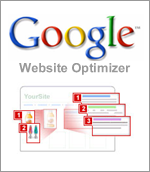 Google’s new “website optimiser” is one of the biggest and most exciting user research tools to emerge on the scene in quite some time.
Google’s new “website optimiser” is one of the biggest and most exciting user research tools to emerge on the scene in quite some time.
It’s a bit surprising, then, that hardly anyone in the User Centred Design field is talking about it. Perhaps it’s passed a lot people by – after all, it does have a rather bland name, it’s been released alongside Adwords (their advertising product), and the sales blurb says that it’s for “online marketers”, which is not a title normally associated with UCD.
Basically, Google Website Optimizer allows you to evolve your site using live user data. You give it a number of different page elements and it alternates between combinations of them on your live site. It gathers performance data (i.e. click-throughs) and you get a live report on which combination is the most successful.
It’s like natural selection- the good combinations win, the bad ones die, and you sit back and watch it all happen.
But it won’t solve all your design problems – it doesn’t compete with traditional UCD tools like lab-based user testing, participatory design and so on. Its place is at a very specific part of the design process, when you have some very specific questions to ask. Here’s a quick illustration:
A few months ago I did some user testing for a .com start-up who was focussing on achieving a huge number of sign-ups. We held 8 one-on-one user sessions on a prototype of their website. Afterwards we had some great findings. Users had real difficulties understanding the proposition of their service – it was just so new and weird, they have nothing to compare it to. Through a process of behavioural observation, interviewing and low-fi design exercises, we nailed down where the problems were and how to solve them. By the end of it we had a new tag line and step-by-step explanation of the service that most users grasped instantly.
This is something that Google Website Optimizer would not have been able to do. It can’t talk to your users to find out what they are thinking, and it can’t engage with them creatively. With Google Website Optimizer, all the richness of your customers’ needs, goals and expectancies gets left behind. All you get is some numeric data showing what they clicked.
Going back to the example scenario – by the end of the project debrief meeting we got to a point where many of the big issues had been dealt with, but lots of smaller issues started cropping up. Should the copy on the registration button read “Join” or “Sign up”? Should it have some associated copy like “No credit card needed” or “First month free”? What about the bullet points on the front page? We had 6 good ideas but we only had space for 3 bullet points, so which should we choose? You get the picture – we’d sorted out the big issues, but now we needed to finesse. This is exactly where Google Website Optimizer should come in.
In summary: it’s fantastic, but not a magic bullet. Consider it just another tool in your User-Centred Design toolbox.